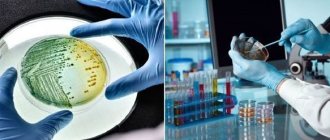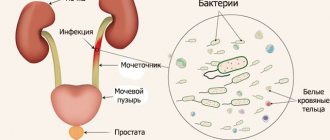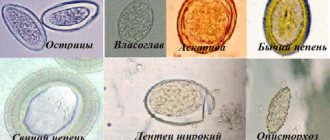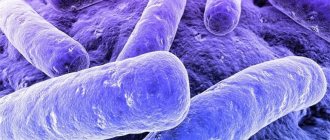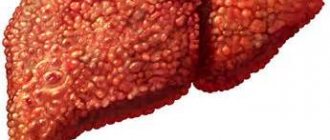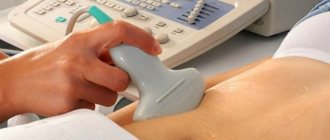08/25/2020 Note
- Where to get tested Indications for the study
- How is the analysis taken?
The enterobiasis test is designed to detect pinworm eggs. The causative agent of enterobiasis is a thin white nematode - the pinworm. It lives in the large intestine and gets its name from the pointed tail of the female. Crawling out from the rectum, pinworms lay eggs in the folds of the anus. Pinworm larvae cause perianal itching, usually during sleep, which is sometimes the only sign of pinworm infestation, and adult individuals lead to disruption of intestinal function.
The main group of infected people are children from 3 to 10 years old (most often from 4 to 6 years old). Infection occurs from a sick person during ingestion of pinworm eggs. The transmission route is contact-household. Causes of infection:
- insufficient hand hygiene;
- contamination of household items, including children’s toys, with helminth eggs.
On the surface of objects, pinworm eggs remain invasive for up to a month. They are resistant to treatment with disinfectants, not all of which are capable of killing helminth eggs.
Self-infection and retroinfection
The first human infection occurs from another “host” of pinworms. Subsequent methods usually come down to self-infection. If hygiene rules are not followed and treatment is not carried out, the cycle from laying eggs to ingesting them and laying new eggs can last a lifetime.
In 70% of those infected, the first symptoms occur when the females emerge from the anus to lay eggs. Laying occurs at night and is accompanied by itching of varying intensity in the perianal area. A person, especially a child, can itch in their sleep without even knowing it.
In the morning, if a person does not wash his face and immediately sits down to breakfast, eggs from the fingers and from under the nails will fall onto the food, and with it into the gastrointestinal tract. You can simply touch your face - and this is enough for infection.
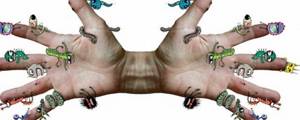
You can transfer eggs from the anus to the mouth after visiting the toilet. If eggs get on your fingers and your hands are not washed, the eggs will sooner or later end up inside the person along with the food.
If basic hygiene is not observed, pinworm larvae can hatch from eggs and on the mucous membrane of the anus. They migrate up the intestines where they grow and develop. This mechanism of infection is called retroinfection.
External contamination
From the skin around the anus, eggs fall not only onto fingers, but also onto underwear, clothes, furniture, pets, and carpets. At home, they remain viable for up to 3 weeks.
From all these objects, the hair of pets (which themselves are not infected), eggs can get on the hands, clothes of other family members, guests, and other visitors to the apartment. If they do not wash their hands before eating, the eggs will end up in the gastrointestinal tract and the pinworm development cycle will begin.
Eggs can also be inhaled with dust. They will again enter the intestines through the nasopharynx.
Helminth infestations are especially large-scale in kindergartens, schools, and holiday camps. If at least 1 child in an institution or place of collective recreation is diagnosed with pinworms, everyone should undergo treatment. The same applies to family members.
To prevent further infection, wet cleaning with disinfectants is carried out in all rooms, linen is changed, and all surfaces, toys, and plants are treated. Pets, as active carriers of pinworm eggs, are washed with special shampoos or laundry soap.
Symptoms of enterobiasis
Up to 30% of people infected with pinworms do not feel any discomfort. With personal hygiene and without re-infection from other people, enterobiasis goes away without treatment.
The most common symptom is itching in the anus. Since it occurs mainly at night, parents may not notice for some time that the child is itching, especially if he is already old enough and performs hygiene procedures on his own.
With a prolonged course and an increase in parasitic load, scratching becomes extensive and very painful, and secondary dermal infections are possible.
If the infection is not treated, autoinfection lasts several cycles, symptoms expand and may include:
- change in appetite - from “wolfish” to complete absence;
- abdominal pain of various types, tenesmus - nagging, sometimes very severe pain in the rectal area;
- grinding teeth during sleep (bruxism);
- headache;
- increasing diarrhea or liquefied stools to a pasty consistency;
- periodic “unreasonable” nausea, vomiting;
- sleep disturbance;
- dizziness, attention disorder;
- prolonged cough, runny nose;
- allergic reactions that have not previously occurred;
- dryness, lethargy, pallor of the skin;
- rashes on the arms, legs, stomach, often itchy;
- enuresis;
- Girls may develop vulvitis or vulvovaginitis - this happens because pinworm larvae that hatch on the anal mucosa can migrate to the genitourinary tract.
These are common symptoms for children and adults. Children, in addition to what has been said, may lag behind in development, become capricious, “nervous,” and experience frequent mood swings.
Treatment methods for enterobiasis
Treatment of enterobiasis is carried out by pediatricians, and in adult patients - by gastroenterologists.
For treatment success, it is important that all family members are treated at the same time. Careful personal hygiene is also necessary. When treating children, parents need to pay special attention to the child’s hygiene.
Anthelmintics
Anthelmintic drugs are used in the treatment of enterobiasis.
Make an appointment Do not self-medicate. Contact our specialists who will correctly diagnose and prescribe treatment.
Rate how useful the material was
thank you for rating
When are tests for enterobiasis prescribed?
Tests for enterobiasis are prescribed if there are clinical or preventive indications:
if the patient complains of itching in the perianal area, there are traces of scratching;
- if a child needs to undergo examination before enrolling in a preschool or school institution, before visiting a sanatorium, holiday camp, enrolling in a swimming pool and in similar cases;
- if an adult gets a job (according to the sanitary requirements of the institution);
- when undergoing a routine medical examination;
- when diagnosing helminthiasis in children and adults with whom a person has contact.
References
1. Clinical recommendations (treatment protocol) for providing medical care to children with enterobiasis. FSBI NIIDI FMBA of Russia, 2014.
2. “MUK 4.2.3145-13. 4.2. Control methods. Biological and microbiological factors. Laboratory diagnosis of helminthiasis and protozoa. Guidelines" (approved by Rospotrebnadzor on November 26, 2013).
3. R. S. Arakelyan, N. A. Sergeeva, V. Sh. Sangadzhieva, O. V. Konnova, A. N. Zagina, A. A. Obukhova. Clinical and epidemiological aspects of the course of enterobiasis in school-age children. Children's infections. 2018; 17(1): 50-53.
4. Infectious diseases: national guidelines / Ed. N.D. Yushchuka, Yu.Ya. Vengerova - M.: GEOTAR-Media, 2010. - 1056 p.
5. V.P.Sergeev Atlas of clinical parasitology and tropical medicine. Authors Academy. Partnership of scientific publications KMK, 2010
How to prepare for analysis
This study does not require any special preparation. It is important to collect material immediately after sleep, before hygiene procedures. In the evening there is no need to wash the perineum with disinfectants, lubricate the perianal area with creams, ointments, healing preparations (if there is scratching).
The result of the study and its accuracy may be affected by taking anthelmintic drugs 14 days or less before collecting the biomaterial. If you have taken any deworming medications, be sure to tell your doctor or nurse.
Stool analysis
- Stool examinations should not be carried out earlier than 2 days after an enema, an X-ray examination of the stomach and intestines, or a colonoscopy.
- You cannot take medications the day before, including: - laxatives; - Activated carbon; - preparations of iron, copper, bismuth; - use fat-based rectal suppositories.
- Do not allow urine or water into the sample.
- Conduct stool examinations in women during menstruation
Stool should be collected for examination in the morning. If this is difficult, you can prepare the sample in advance, but no more than 8 hours before submitting the stool to the laboratory. In this case, the sample should be stored in the refrigerator (do not freeze).
Thorough toileting of the external genitalia and anal area. Pre-urinate. Defecate in a dry, clean container: a vessel or a night vase. Transfer a stool sample of 3-5 cubic meters. cm in a pre-prepared, clean, dry container for storage and transportation.
Feces for occult blood
The patient should not eat meat, fish, or tomatoes 3-5 days before the test (they can be replaced with dairy and cereal dishes). The patient should not brush his teeth. The material is collected on the fourth day in a clean, dry container for storage and transportation.
Types of studied material and collection rules
To study enterobiasis, patches, scrapings, smears from the skin in the perianal area are used, and, if necessary, skin scrapings from under the nails. Analysis of this biomaterial has the greatest sensitivity and allows you to make a diagnosis with confidence.
Feces are rarely used for analysis, because pinworms practically do not lay eggs in the intestines - such biomaterial is not informative. Feces make it possible to diagnose enterobiasis during a long course of the disease and mass intestinal invasion by pinworms. In this case, helminths are visible on the surface of the feces with a simple macroscopic examination.
Examination of scrapings for enterobiasis
Important! Taking scrapings for enterobiasis is carried out independently. You must first obtain consumables from the medical office for scraping.
Analysis of scrapings for enterobiasis
is a rapid test for the most common helminthiasis caused by pinworms - small roundworms. This parasite lives in the lower parts of the large intestine and lays eggs in the perianal folds (outside the anus). Infection occurs through the fecal-oral route, and both infection through consumption of insufficiently processed food and self-infection are possible. Enterobiasis is common mainly in children of preschool and primary school age. The most noticeable clinical manifestations are itching in the perianal area, allergic reactions and intestinal disorders. Enterobiasis is one of the most common parasitic infestations in children. It is common even in highly developed countries. According to various studies, the infection rate of children with such parasites ranges from 4 to 28 percent.
The nutrient medium for pinworms is mainly the contents of the intestines. A characteristic symptom of enterobiasis - itching in the perianal area - appears at the moment when parasites lay eggs on the skin. One pinworm can lay up to 1.5 thousand eggs. After this she dies. In most cases, when itching occurs, the child begins to scratch the skin, and pinworm eggs get under his nails. Then they end up on toys, furniture, and personal hygiene items. From them the eggs end up in the hands of other people. The main problem in the spread of pinworms is lack of hand hygiene. From them, parasite eggs enter the mouth, and thus infection occurs. This is why children most often suffer from enterobiasis. The likelihood of infection is especially high in places where children gather in large numbers (kindergartens, entertainment centers, etc.).
The high prevalence of the disease is largely due to mild symptoms. Parents often do not pay attention to the appearance of perianal itching in their child. An infected child can infect other children over a long period of time. Most often, the disease is mild, but aggravated helminthic infestation is also possible. Symptoms such as insomnia, causeless anxiety, and loss of appetite may appear. With a severe and prolonged course of the disease and the absence of timely diagnosis and proper treatment, mental development disorders may occur in children. In rare cases, ectopic enterobiasis develops in the fallopian tubes or kidneys, which is fraught with the development of serious complications. Perforation of the small intestine and pinworms entering the abdominal cavity are also possible. In such cases, acute appendicitis develops, and peritonitis is possible. Sometimes other complications appear. They develop infrequently, but the risk of complications exists, so if symptoms appear or the disease is detected during a preventive examination, treatment should not be neglected. In the case of prolonged invasion, constant intoxication of the body is observed.
A positive test result indicates the presence of helminthiasis. In the treatment of the disease, along with drug treatment, hygiene measures play an important role. These include regularly changing linen (it must be ironed after washing), washing hands, and cutting nails. Failure to comply with these rules leads to re-infection. Drug treatment is prescribed only by a doctor; self-medication is unacceptable. In many cases, contacts are also advised to undergo treatment. Prevention of helminthiases consists of observing the rules of personal hygiene. It is advisable to teach them to children from an early age to reduce the risk of infection. Also, on the recommendation of the attending physician, medications may be prescribed for routine drug prevention in high-risk groups.
How to collect material yourself
To collect the material yourself, you need to obtain it from the laboratory, the registry office of a medical institution, or buy a scraping kit at the pharmacy. It usually includes a polystyrene spatula, on the working marked edge of which acrylic water-dispersed adhesive is applied. This edge must not be touched with hands, it must not be applied to surfaces other than those being examined, and it must not be removed from the container before collecting the biomaterial.
A scraping (imprint) is taken from the skin folds of the perianal area in the morning, before bowel movements and hygiene procedures. It is necessary to spread the buttocks as wide as possible, apply the spatula with the adhesive surface to the skin of the perianal area to get an imprint.
The spatula with scraping is placed in a container and closed tightly. The biomaterial is delivered to the laboratory strictly on the same day.
Instead of a spatula, the kit may include a swab, adhesive tape and a glass slide. In this case, they act in a similar way: they collect biomaterial in the perianal area on a tampon or tape, pack them according to the instructions in a container, and deliver them to the laboratory. Delivery time can vary from 3 to 8 hours - you need to find out about it in advance at the medical institution.
Analysis of urine
General urine analysis
- On the eve of the test, it is recommended not to eat vegetables and fruits that can change the color of urine (beets, carrots, etc.), and not to take diuretics.
- Before collecting urine, it is necessary to perform a thorough hygienic toilet of the genitals.
- Women are not recommended to take a urine test during menstruation.
Collect your morning urine in a container. To properly conduct the study, during the first morning urination, release a small amount of urine (the first 1 - 2 seconds) into the toilet, and then, without interrupting urination, place a urine collection container into which to collect approximately 50-100 ml of urine. Close the container tightly with the screw cap.
A specialized plastic container is the optimal means of collecting and transporting urine for laboratory research. Ask at pharmacies. The container is a wide-neck graduated translucent glass with a capacity of 125 ml with a hermetically screw-on lid. The container is sterile, does not require pre-treatment and is completely ready for use.
Nechiporenko test
To analyze urine using the Nechiporenko method, the morning portion is collected in the middle of urination (“middle portion”). 15-25 ml is enough.
24-hour urine collection
For laboratory studies, in the morning before collecting urine, it is necessary to toilet the external genitalia.
The first morning urine sample is not collected, but the time of urination is noted. Subsequently, all urine excreted in 24 hours from the marked time of the first urination to the same hour the next day is collected.
The collection of daily urine is optimally carried out in a specialized graduated plastic container of 2.7 liters, which has a wide neck and a textured handle. The container is safe and easy to handle.
You should urinate directly into the container and screw the lid tightly after each urination. Urine should be stored in a closed container in the refrigerator on the bottom shelf, avoiding freezing.
At the end of the collection (the last urination is performed at the same time, which is marked as the time of the first urination, but one day later), the urine can be submitted to the laboratory: the daily volume of urine in a closed container is shaken, after which it is poured into a small container for clinical urine analysis of 125 ml 100 ml portion. You don't need to bring all your urine. At the medical center, report the daily amount of urine.
Collection of daily urine according to Zimnitsky
Urine is collected per day (8 servings in 8 containers, every 3 hours). The first portion of urine in the morning is removed. All subsequent portions of urine excreted during the day, night and the morning portion of the next day are collected in different containers (50 ml) purchased at the pharmacy, each with the time of collection signed.
After collecting urine, accurately measure the contents of the container, be sure to mix it and immediately pour it into a container purchased at the pharmacy. Bring the container to the medical center for examination. You don't need to bring all your urine. At the medical center, report the daily amount of urine.
Urine for sugar
From the daily amount of urine, 50-100 ml of urine or 3 portions of urine collected per day with intervals of 8 hours are delivered to the laboratory:
1 serving - from 8 to 16 hours
2 servings - from 16 to 24 hours
3 servings - from 24 to 8 am (as directed by a doctor).
Urine for PCR studies (tuberculosis, CMV, STIs)
Before collecting urine, it is necessary to toilet the external genitalia. Urine is collected in the morning on an empty stomach after sleep or no earlier than 2-3 hours after the last urination into a sterile plastic container. The minimum volume of urine required for analysis is 20 ml.
Urine for bacteriological research
The urine sample is collected only in a sterile container.
Urine must be collected before starting antibacterial treatment or 3 days after therapy. If the patient is taking antibacterial drugs, then it is necessary to decide on their temporary withdrawal.
After thoroughly toileting the external genitalia, flush the first portion of urine into the toilet, collect the middle portion of 3-5 ml in a sterile hermetically sealed container. Deliver the urine to the laboratory within 1-2 hours; if this is not possible, then the urine sample can be stored in the refrigerator for no more than a day. When transporting the sample, care must be taken to ensure that the stopper does not get wet.
Diagnostic methods and interpretation of results
The most common diagnosis of enterobiasis is the microscopic detection of helminth eggs in smears, scrapings of subungual contents and skin in the perianal area, and patches from the surface of the perianal area.
Normally, there should be no eggs in the biomaterial. If at least 1 viable egg or remains of a worm are found, a positive diagnosis is made.

To be sure of sterility from pinworms or helminth infestation, you need to undergo at least 3 studies at intervals announced by the doctor.
Completion time, cost of analysis for enterobiasis at JSC "SZDCM"
The cost of testing for the presence/absence of pinworms in laboratory and medical terminals is one of the most affordable in St. Petersburg, the Leningrad region and other cities and towns where our branches are located.
The price of the study depends on whether you collect biomaterial yourself or use the services of a nurse.
The duration of the study is 1 day. Results are delivered in person or sent by email*.
Participation of a nurse in laboratory tests of a patient
Laboratory research methods
Laboratory research methods - study of biological material ( biosubstrates
).
Biomaterials - blood and its components (plasma, red blood cells), urine, feces, gastric juice, bile, sputum, effusion fluids, parenchymal organ tissue obtained by biopsy
.
Purpose of laboratory research:
- establishing the etiology of the disease (its cause); sometimes this is the only criterion for assessing a clinical situation - for example, infectious diseases;
- prescription of treatment;
- monitoring the effectiveness of treatment over time.
Laboratory tests are ordered and evaluated by a physician. Laboratory staff are responsible for the laboratory stage. In the preanalytical stage, the nurse plays an important role:
- prepares the patient for the study, provides him with laboratory glassware, issues a referral for the study;
- collects biomaterial and ensures proper storage;
- transports the material to the laboratory.
The reliability of the research depends on how well this stage is completed.
Types of laboratories, their purpose
Clinical and diagnostic
Determination of physicochemical properties of biological substrates and microscopy. For example, general analysis (blood, urine, sputum, feces), urine tests according to Zimnitsky and Nechiporenko, feces for occult blood, feces for helminth eggs, general analysis of gastric juice and bile, exudates and transudates, cerebrospinal fluid, etc. To transport biomaterials to the laboratory, clean, dry glassware or special disposable containers are used.
Biochemical
Determination of chemical properties of biological substrates. For example, liver blood tests (total protein, bilirubin, thymol and sublimate tests), blood for rheumatic tests (C-reactive protein, formol test), study of lipid metabolism (beta-lipoproteins, total cholesterol), enzymes (ALAT, ASAT, LDH and etc.), study of carbohydrate metabolism (blood glucose), blood test for iron, electrolyte content, biochemical study of bile and urine, etc.
Bacteriological (clinical microbiology laboratory)
Detection of microbial composition and identification of microflora (blood for sterility, urine for bioculture, feces for intestinal group and dysbacteriosis, swab from the throat and nose if diphtheria and meningococcal infection are suspected, serological blood tests, etc.). To collect the material, you must obtain sterile laboratory glassware. Material should be collected before starting antibiotic therapy.
Where to get tested for enterobiasis
You can get tested for pinworm infestation and other human parasites at any of the laboratory terminals, medical centers and departments of JSC SZDCM. They are located in St. Petersburg, Leningrad region, Veliky Novgorod, Novgorod region, Baltiysk.
You can also select the nearest medical facility on the interactive map - they are marked with green marks. Hover your cursor over the label and you will see the exact address of the medical facility in the pop-up menu.
In all branches of JSC "SZDCM" you will be met by attentive, friendly employees who will delicately help you pass even “inconvenient” tests. If the result of the study is positive, you will be treated with even more care and compassion - our employees work to help people in any situation, especially difficult and uncomfortable ones.
Analyzes
- Taking biomaterial for enterobiasis
- Scraping for enterobiasis

